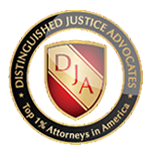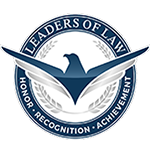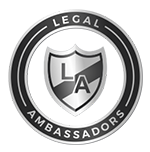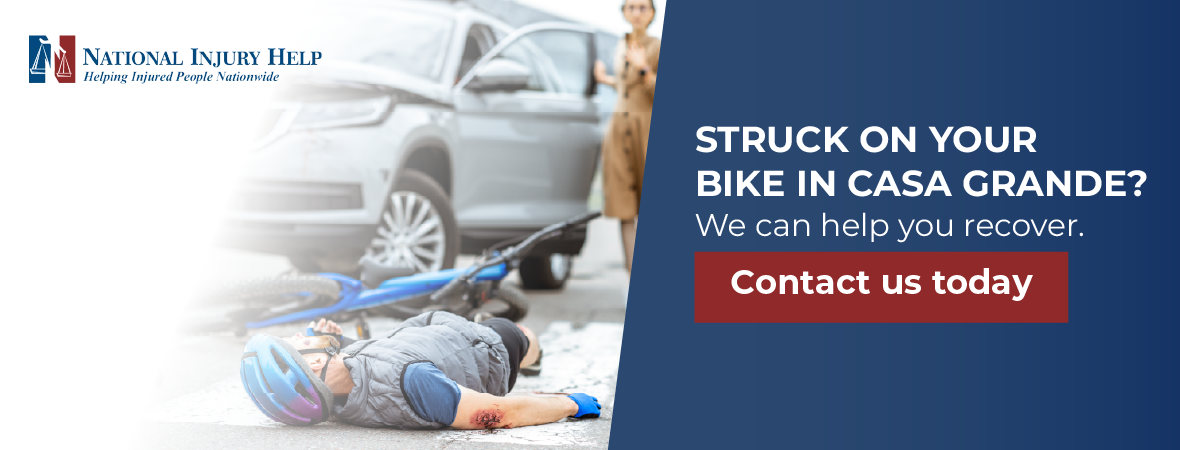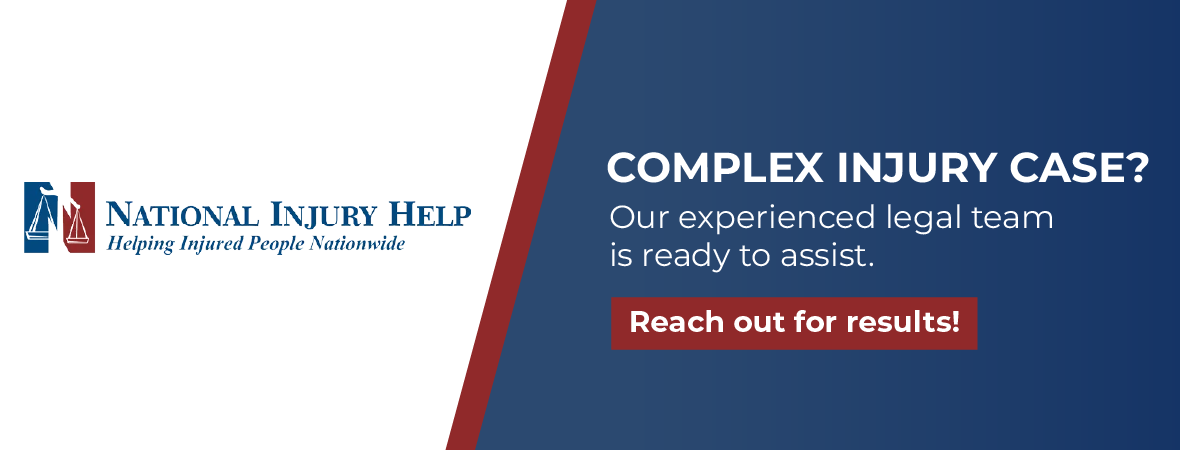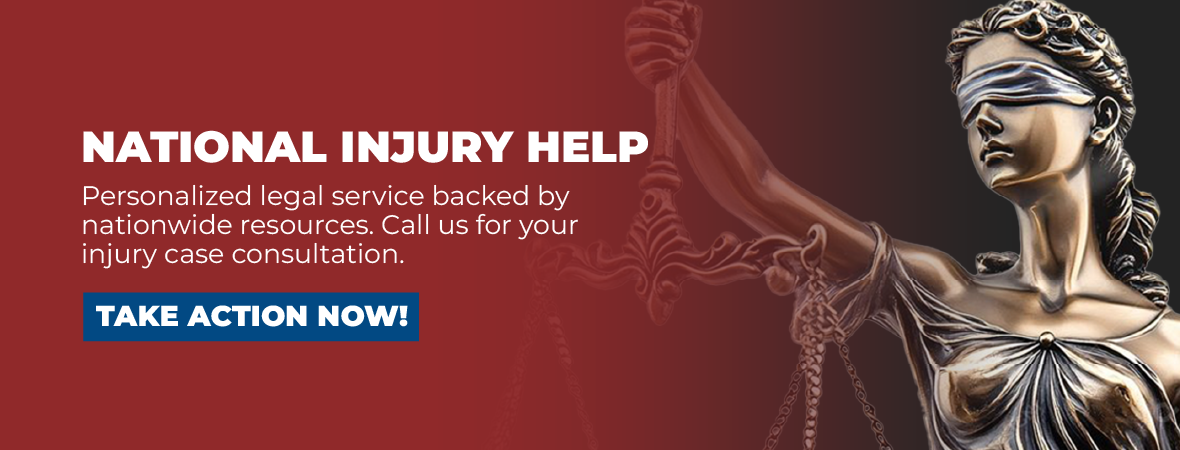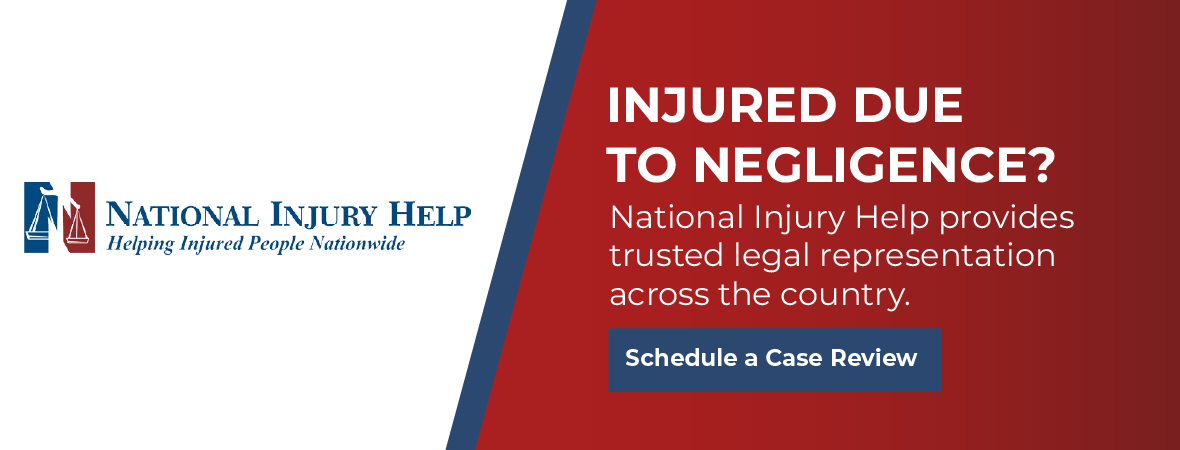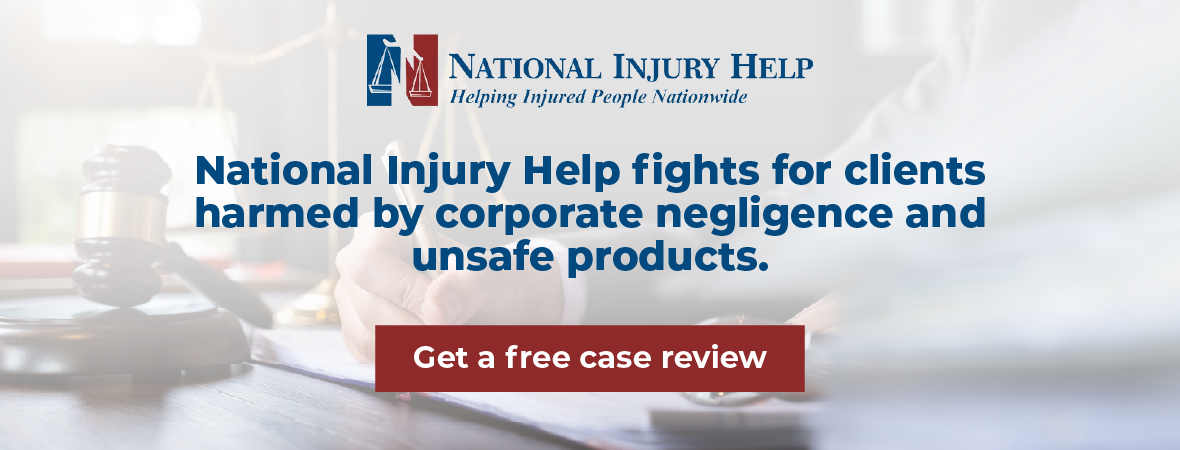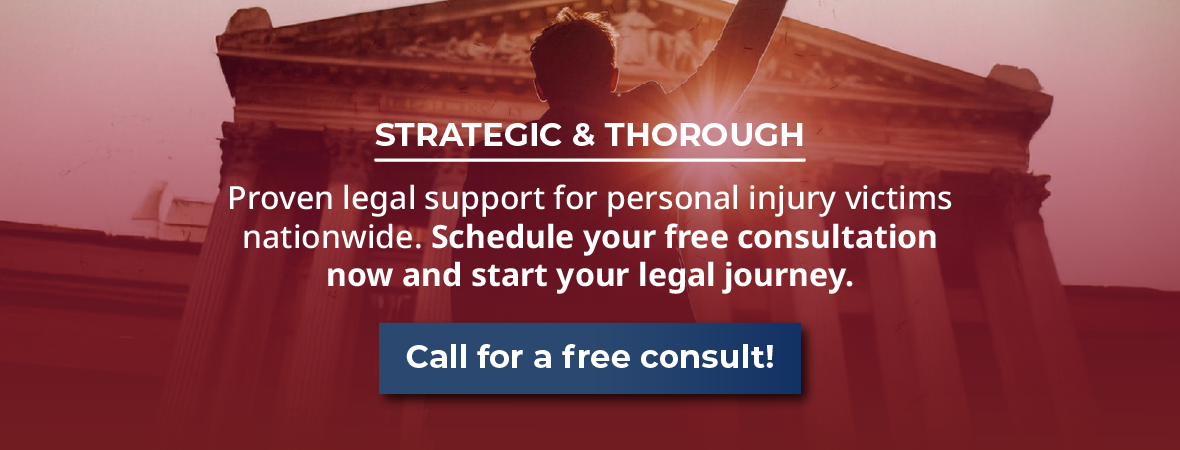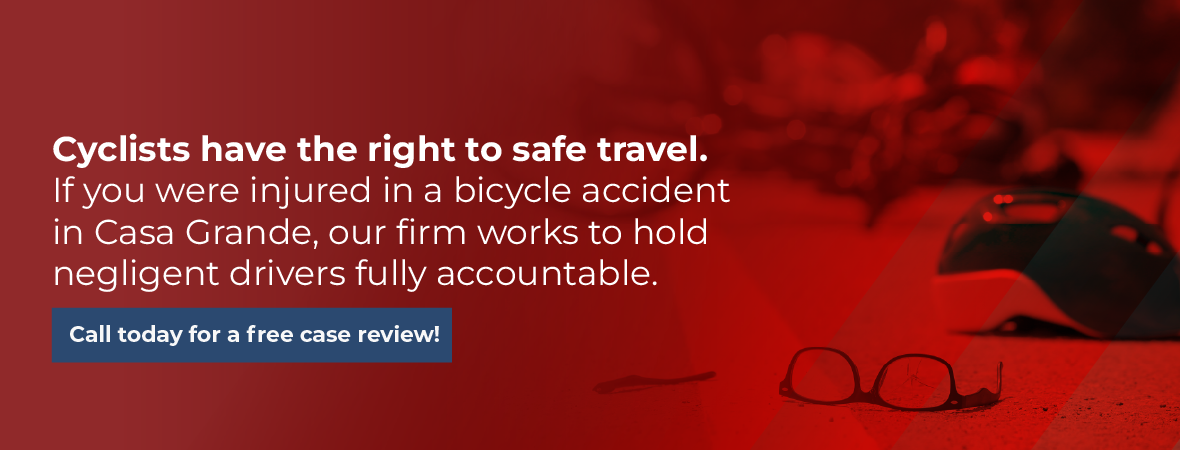If you were hit while riding a bike in Casa Grande, you may be facing serious injuries and unexpected expenses. Contact National Injury Help by calling 1 (800) 214-1010 today. We are here to protect your rights and support your recovery.
You get on your bicycle for many different reasons. Maybe you ride to save gas during the workweek, or perhaps you head out every Saturday to enjoy the warm desert wind on the Casa Grande Canal Trail. No matter why you pedal, you trust that drivers will pay attention, that streets will stay in good condition, and that you will reach your destination without trouble.
Sadly, one careless moment from a motorist or one hidden pothole can turn a peaceful ride into a visit to the emergency room. A bicycle crash can cause serious injury even when the car is moving at what seems like a slow speed, because your body has no metal cage to protect it.
Casa Grande continues to grow. New subdivisions fill farmland in every direction, delivery vans rush down Florence Boulevard, and large trucks enter and exit Interstate 10 all day long. Mixed-use paths run next to busy roads, and bike lanes appear and disappear with little warning.
All of these changes bring more risk for cyclists. When a crash happens, medical bills will come first, and insurance companies will follow close behind. Adjusters may claim you were riding too fast, that you were outside the bike lane, or that your injuries are minor. You deserve help that comes from someone who knows the local streets, understands Arizona bicycle laws, and has spent years challenging unfair tactics.
Our team at National Injury Help does exactly that. We guide people who were hurt on bikes through every step of a legal claim, starting with collecting evidence and ending with payment that covers hospital care, lost wages, and the pain that no paycheck can erase.
We will also break down Arizona bicycle rules, list all potential at-fault parties, show how a local lawyer lifts the burden from your shoulders, detail the damages you can pursue, and answer the questions riders ask us every week. When you finish reading, you will understand your rights and know exactly how to begin your path toward recovery and fair compensation.
Why Bicycle Accidents Are So Dangerous for Riders
Riding a bike offers exercise, fresh air, and a sense of freedom, yet it exposes you to risks that drivers rarely consider.
In Casa Grande, those risks grow because traffic moves quickly, bike lanes end without notice, and the desert sun hides cracks and debris in bright glare. Understanding the dangers helps you explain your injuries to doctors, to insurers, and if necessary to a jury, so this section starts the story.
Lack of Protection
When you pedal, your helmet is the only real barrier between you and the outside world. The helmet protects part of your head, but nothing covers your face, arms, spine, or legs. A car has a steel frame, crumple zones, seat belts, and airbags that absorb force.
A bicycle has thin tubing and two tires no wider than your hand. During a collision, your body absorbs nearly all the energy. Even a small bump from a bumper can send you over the handlebars, and sliding only a few feet along rough asphalt can scrape away layers of skin, muscle, and confidence.
Vehicle Driver Negligence
Many crashes begin with a simple failure to look. A driver may glance in the rear-view mirror but forget the side mirror, or may check both mirrors yet never turn a head to clear a blind spot.
Because bikes are narrow, they hide behind roof pillars and door frames. Some motorists assume cyclists ride at walking speed and misjudge how quickly the bicycle approaches an intersection.
Phone use pulls eyes away from the road for several long seconds, and by the time the driver looks up, it is often too late to brake. Nighttime creates another danger, because one small white headlight can appear farther away than it is, and the dark clothing that keeps you cool can blend into the surroundings.
Dangerous Infrastructure
Good road design separates bikes from cars, gives clear signals, and keeps surfaces smooth. In Casa Grande, infrastructure is a mix of older streets built when bikes were rare and new projects that still place car flow first.
A painted bike lane on Trekell Road may vanish at the next traffic light, and a wide shoulder can turn into gravel when the pavement ends. Construction crews leave raised metal plates that create slippery ramps, and signage may fail to warn drivers that cyclists share the path ahead.
Poor drainage after a monsoon storm leaves puddles that hide deep potholes. These gaps in planning and maintenance magnify every risk a rider faces.
Speed Differential
Physics favors the heavier object. Even when a car moves at only twenty miles per hour, it still weighs several thousand pounds. Your bike and body together may weigh less than two hundred pounds. When the two objects collide, momentum and force travel directly into you.
If you and the car travel in the same direction, the driver often needs extra distance to stop, because the cyclist’s slower pace shortens the gap faster than the driver expects. When the impact happens head-on or from the side, the difference in mass means the bike comes to a sudden stop while the car continues moving, which doubles the force on your joints and bones.
That is why crashes that look minor to onlookers can leave cyclists with broken ribs, torn ligaments, and spinal injuries that last a lifetime.
Common Causes of Bicycle Accidents in Casa Grande
No two crashes look exactly alike, yet patterns appear again and again in police reports and hospital charts. Casa Grande’s blend of downtown streets, suburban neighborhoods, and farm roads creates a unique mix of hazards.
Knowing these causes helps you push back when an insurance adjuster tries to claim the crash was just bad luck.
Dooring
Downtown parking spots line Florence Boulevard and First Street, and many cafes encourage guests to park on the curb. A driver or passenger who steps out without looking into the bike lane can swing a door directly into your path.
Because the door appears only inches in front of your wheel, you have no time to swerve or brake. Hitting the door edge launches you forward, and often your shoulder meets the top corner while your hip slams the lower hinge.
The driver may jump in surprise and close the door, which moves the obstacle and makes it harder to prove what happened. Quick photos and witness names become crucial.
Left- and Right-Turn Accidents
Intersections create confusion, especially during rush hour. A driver who wants to turn left onto Cottonwood Lane may believe you are far away because you look smaller than a car, so the driver pulls across your lane.
You brake hard, the tires skid, you lose balance, and you strike the fender or land in the crosswalk. Right-hand turns cause trouble when a driver overtakes you, forgets your presence, and cuts right to reach a store parking lot. The rear of the car knocks your front tire, throws you sideways, and often places you under the side doors where the driver may not see you.
Distracted or Impaired Drivers
Texting while driving remains one of the leading factors in bike crashes. A driver who reads a short message at forty miles per hour travels more than a football field with eyes off the road.
Alcohol and drugs slow reaction time, narrow peripheral vision, and make speed judgments unreliable. Fatigue creates similar effects. A delivery driver who has worked twelve hours may drift across the white line, and because bicycles ride on the far right, you are the first object that a drifting vehicle meets.
Failure to Yield at Intersections or Crosswalks
Casa Grande’s wider roads encourage higher speeds, and some drivers treat stop signs as mere suggestions. At a four-way stop on Korsten Road, a driver may roll forward, thinking you will stop, but state law says the first vehicle to arrive and fully stop gains the right of way. School zones near Cottonwood Elementary add more hazards because parents hurry to pick up children and may not expect a cyclist to enter the crosswalk.
Signalized intersections create conflicts when drivers turn right on red without a complete stop. They look left for oncoming cars and never turn their eyes right, where you stand waiting on the curb ramp.
Road Hazards
Construction season brings loose gravel and uneven pavement. Farm equipment drops mud and hay on Thornton Road, creating slick spots when you least expect them. Potholes grow larger after each summer monsoon because water seeps into cracks and the sun bakes the edges.
When a thin front tire meets a hole, the wheel stops suddenly, and your momentum carries you over the bars. Broken glass from a previous fender-bender can slice a tire, leading to a loss of control. Each of these conditions exposes the city or county to possible liability, but only if you gather proof before crews sweep the street clean.
Common Injuries in Bicycle Accidents
A bicycle crash sends energy through every part of your body, and the injuries vary according to speed, angle, and surface. Understanding these injuries helps you track symptoms and demand compensation that covers both today’s hospital bill and tomorrow’s therapy session.
Head and Brain Injuries
The head hits first in many falls because momentum tips you forward. A mild concussion can cause headaches, blurred vision, and memory gaps that last days or weeks. A skull fracture adds the risk of infection or bleeding. Severe traumatic brain injuries change speech, balance, and personality.
Some riders need cognitive therapy to relearn daily tasks, and the cost of that therapy can last for years. Even with a helmet, rotational forces can cause brain tissue to stretch and tear, leading to diffuse axonal injury that is hard to diagnose but deeply life-altering.
Broken Bones and Fractures
Arms instinctively reach out to break a fall, so wrists, elbows, and collarbones break often. The thin clavicle supports little more than the weight of your arm, so it snaps when the shoulder meets the pavement.
Ribs fracture when a curb or door edge presses against the chest wall, making every breath a chore. Leg fractures limit mobility and can keep you off work for months, especially if your job requires standing.
Pelvic breaks, while less common, require long bed rest and create complications such as blood clots. Each break demands imaging, casting, and sometimes surgery with plates and screws.
Soft Tissue and Internal Injuries
Muscles and organs hide damage until pain arrives hours later. A handlebar can strike the abdomen and bruise the liver or spleen. Internal bleeding may not show on the skin, yet blood pressure drops and dizziness increase.
Deep cuts from broken glass or chainrings can slice tendons, leaving fingers numb. Swelling inside joints causes stiffness that therapy must reduce before scar tissue sets in. Insurance adjusters often doubt soft tissue claims because X-rays look clean. Detailed medical notes and early diagnostic scans support your case.
Spinal Cord Injuries
A sudden twist or compression can crack vertebrae and pinch the spinal cord. Swelling that seems small can still block nerve signals, leading to temporary paralysis that sometimes becomes permanent if treatment is delayed.
A complete spinal cord injury below the neck removes movement and feeling in the legs, and sometimes the torso. Even partial injuries that allow limited movement require months of rehab, adaptive equipment, and home modifications. The lifetime cost of care can reach millions of dollars, which makes precise legal work essential.
Psychological Effects
The mind remembers every screech and every flash of metal. Post-traumatic stress can trigger nightmares or panic attacks when you approach an intersection that looks like the crash site.
Depression may develop, especially if injuries prevent you from riding, working, or caring for children. Fear of roads can linger long after bones heal. Counseling and medication help, yet insurers treat mental health care as optional. Documenting every session shows the real cost of emotional recovery.
What to Do After a Bicycle Accident in Casa Grande
The minutes after a crash feel chaotic. Pain, sirens, and traffic create confusion, but calm action now makes legal steps easier later.
Call 911 and Seek Medical Help
Always call emergency services even if you think your injuries are minor. The adrenaline rush hides pain. Paramedics check vital signs, immobilize fractures, and choose the right hospital. Banner Casa Grande Medical Center has imaging machines to find hidden injuries. Early treatment prevents complications and ties the injuries to the crash time.
Report the Incident to Police
Arizona law requires a police report when injuries occur. Officers measure skid marks, talk with witnesses, and list each party’s account. Ask for the report number before you leave. The document becomes key evidence because memories fade, but reports do not.
Document the Scene
If you can move safely, use your phone or ask a friend to take photos. Capture the overall intersection, then move closer to show your damaged bike, the vehicle, and the road surface. Include street signs and traffic lights.
Photograph your helmet, clothing, and visible injuries before paramedics treat them. Images freeze the truth before rain washes it away or tow trucks clear debris.
Collect Witness Contact Information
Bystanders often stop to help. Speak calmly and ask for full names, phone numbers, and email addresses. Jot down a brief note about where each person stood and what they saw first. Independent witnesses add credibility when the driver’s story changes.
Do Not Talk to Insurance Companies Alone
Within hours or days, an adjuster may call, appear friendly, and promise quick payment. The adjuster’s real goal is to save the company money. Provide only your name, contact information, and the date and location of the crash.
Politely explain that all future questions must go through your lawyer. Never agree to a recorded statement without legal guidance, and never sign any release before you understand the full cost of your injuries.
Arizona Bicycle Laws That Could Impact Your Case
Laws shape fault decisions and damage awards. Knowing the rules empowers you and helps your lawyer prove that you rode responsibly.
Legal Status of Cyclists
Under Arizona Revised Statutes section 28-812, cyclists have the same rights and duties as drivers. That means you can claim a full lane when necessary, and cars must yield as they would to another motor vehicle.
You must obey stop signs and red lights, and you must signal turns with hand motions. This equal status strengthens your claim because a driver who violates your right of way cannot argue that you were a lesser road user.
Helmet Laws
The state does not require adults to wear helmets, and Casa Grande has no local rule that changes this. You may ride bare-headed without breaking the law. However, helmet use still influences negotiations.
Insurers may say that head injuries would be smaller if you wore a helmet. Medical studies show helmets reduce certain injuries, but they cannot prevent all trauma. Your lawyer will bring in experts who explain that fault for the collision still rests on the driver, not the cyclist’s choice of headgear.
Where Cyclists Can Ride
Arizona lets riders use bike lanes when they exist, yet you may leave the lane to avoid hazards or to prepare for turns. Riding on sidewalks is allowed in many parts of Casa Grande, but you must yield to pedestrians.
Shared paths, such as those along Peart Park, invite both walkers and cyclists, so a moderate speed and audible signals keep everyone safe. Knowing where you were allowed to ride at the moment of impact shuts down claims that you were in an illegal spot.
Right-of-Way and Yielding
At T-intersections, a cyclist going straight has priority over a driver turning left across the rider’s path. At marked crosswalks, a cyclist who dismounts and walks becomes a pedestrian with full right-of-way.
Drivers must stop when school crossing guards lower their flags, and they must remain stopped until the entire crosswalk is clear. These rules come into play in school zones near McCartney Ranch Elementary, where morning traffic can be hectic.
Comparative Negligence
Arizona follows a pure comparative fault system. If you share any responsibility for the crash, your compensation decreases by that percentage, but you never lose the entire claim because of partial fault.
For example, if a jury decides you are ten percent at fault for riding outside the bike lane, you still collect ninety percent of the total damages. By gathering proof early, your lawyer minimizes that percentage and maximizes your final payment.
Who Can Be Held Liable in a Bicycle Accident?
Finding every at-fault party means finding every insurance policy that can pay your bills. Liability can spread wider than the driver in the immediate crash.
Negligent Drivers
The most obvious party is the driver who struck you. Speeding, texting, failing to yield, or driving under the influence violates the duty of care that every motorist owes to others. Your lawyer will pull phone logs, obtain toxicology reports if alcohol is suspected, and secure traffic camera footage to prove negligence.
Commercial Drivers or Companies
Delivery vans from large corporations and local businesses travel to Casa Grande daily. If a driver hit you while on a delivery route, the company may share fault for poor training, equipment maintenance, or unrealistic delivery schedules that encourage speeding. Commercial policies often carry higher limits, which is vital when injuries are severe.
City or County Government
Casa Grande and Pinal County must keep roads safe. If they ignore repeated complaints about a pothole or delay fixing broken traffic lights, they may be liable.
Claims against government agencies require a notice of claim within one hundred eighty days. Your lawyer will file this notice on time and gather maintenance logs to show prior knowledge of the hazard.
Property Owners
Private parking lots and driveways create hazards when sight lines are blocked by overgrown bushes or when large cracks form in the pavement.
A store that fails to fix a dangerous curb cut can be held responsible if the defect causes your crash. Security footage and previous repair orders help prove the owner knew about the problem.
Bicycle Manufacturers
A cracked frame or defective brake pad can fail under normal pressure and cause a single-rider crash. While rare, such failures lead to product liability claims. Your lawyer hires engineers to inspect the bicycle and to trace defects back to design or manufacturing errors. If a recall exists, that information strengthens the case.
How a Casa Grande Bicycle Accident Lawyer Helps
Handling medical appointments is hard enough. Adding forms, deadlines, and negotiations can overwhelm anyone. A lawyer removes that burden.
Conduct a Thorough Investigation
We start by visiting the crash scene as soon as possible. We photograph fresh skid marks, measure lane widths, and note the sun’s position if glare played a part. We send letters to local businesses and city departments to preserve any camera footage.
Police reports provide the first layer of information, but we dig deeper by interviewing every witness again and by hiring accident reconstruction experts who create computer models showing speed, angle, and impact force.
Protect You From Insurance Traps
Insurance letters can look harmless, yet one careless sentence may reduce your bike crash claim in Casa Grande. We review every questionnaire, correct misleading language, and insist that adjusters put all communication in writing.
Delays are common. When an insurer stalls, we file complaints with the Arizona Department of Insurance and set firm deadlines that keep the process moving. If an adjuster tries to place part of the blame on you without evidence, we counter with clear documentation that shows who truly caused the crash.
Calculate Full Compensation
Medical bills arrive in waves, and some costs hide in the future. We gather records from emergency physicians, surgeons, physical therapists, and mental health counselors. For long-term injuries, we ask doctors to project future surgeries and medication needs.
Vocational experts explain how time away from work or permanent impairments reduces your earnings over a lifetime. Life-care planners detail the price of wheelchair ramps, modified vehicles, and in-home nursing. We combine these figures into one complete demand, so no expense is left uncovered.
File a Lawsuit if Necessary
Many claims settle out of court, but real leverage comes from readiness to try the case. We draft a complaint that lays out every legal theory, then we enter discovery, which is the evidence-sharing phase.
Depositions place witnesses under oath, and their answers often reveal contradictions that prompt insurers to raise settlement offers. If no fair agreement appears, we present your story to a Pinal County jury, using clear visuals and expert testimony to make complex medical facts easy to grasp.
Contingency Fee Agreements
Legal help should not drain your savings. We work on a contingency fee, which means you pay nothing up front. We advance the costs of filing fees, expert witnesses, and document retrieval.
Our fee comes only from the money we recover for you, and if we do not win, you owe no attorney’s fee. This arrangement aligns our aim with yours because we succeed only when you receive compensation.
What Compensation Can You Claim in a Bike Accident?
Money cannot erase pain, but it can pay for care, replace income, and ease the stress that slows healing. Arizona law allows several categories of damages.
Medical Expenses
Emergency transport, X-rays, CT scans, surgeries, hospital stays, prescriptions, follow-up visits, and physical therapy all belong in the claim. Future needs, such as revision surgeries and assistive devices, count as well.
Lost Income and Earning Potential
If you miss work during recovery, you lose wages. If injuries force a career change or shorten your working life, you lose future earnings. We calculate both, using payroll records and expert projections that show what you would have earned without the crash.
Property Damage
Your bicycle may need repairs or complete replacement. High-end frames, wheelsets, and electronic shifting systems cost thousands of dollars, and insurance often undervalues them. Helmets, lights, camera equipment, and clothing also qualify because each item was damaged in the collision.
Pain and Suffering
This category addresses physical pain, sleepless nights, frustration, and the loss of activities you once enjoyed. A broken wrist might keep you from playing guitar, and nerve damage might stop you from holding your child. We gather statements from family and friends to show everyday struggles that numbers alone cannot capture.
Punitive Damages
When a driver’s conduct is especially reckless, such as drag racing or driving with a very high blood alcohol level, Arizona courts may award punitive damages. These are designed to punish wrongdoers and deter future misconduct. Your lawyer will review the facts to see if punitive damages apply.
FAQs About Bicycle Accident Claims in Casa Grande
Can I receive compensation if I was not wearing a helmet?
Arizona does not require adult helmets, so you can still recover damages if you were not wearing a helmet. The insurer may argue that your head injuries are partly your fault. We counter with medical testimony that shows how impact forces exceed helmet ability and that the driver’s actions are the primary cause.
What if I were partly at fault for the crash?
Under comparative negligence, you can still recover money. So even if you are found partly at fault for the crash, you receive a portion of the total damages, reduced by the percentage of fault assigned to you. Good evidence decreases your percentage of blame.
How long do I have to file a claim?
You normally have two years from the crash date, though claims against government entities require a notice within 180 days to file a claim. Starting early helps preserve evidence and meet every deadline.
What happens if the driver flees the scene?
If the driver flees the scene, police will investigate, and we can pursue compensation through your uninsured motorist coverage. Traffic cameras, witness statements, and paint marks on the bike can help identify the vehicle.
Should I speak to the insurance company on my own?
No, you shouldn’t speak to the insurance company on your own. Provide only basic contact information and then direct all questions to your lawyer. Adjusters are trained to gather statements that lower payments.
Contact a Casa Grande Bicycle Accident Lawyer Today
Evidence fades with each passing day. Street sweepers clear debris, witnesses change phone numbers, and camera footage overwrites itself. The sooner you call a lawyer after a cyclist injury in AZ, the sooner we can secure proof and meet every legal deadline. Local knowledge matters because knowing how Florence Boulevard flows at sunset or how the wind blows sand across Trekell Road can change the way an expert reconstructs the crash.
National Injury Help offers free consultations, and we charge no fee unless we win money for you. We work with doctors across Casa Grande, Arizona City, Eloy, Maricopa, and the surrounding desert communities, so appointment scheduling becomes easier. We will visit you at home or in the hospital if travel is difficult.
If you or someone you love was hit while biking in Casa Grande, call National Injury Help at 1 (800) 214-1010 today. We are ready to listen to your story, explain your rights, and start paving the path toward justice and recovery.

